BRAF V600E mutation and correlation with clinicopathologic features in radioactive iodine refractory papillary thyroid carcinoma
Main Article Content
Keywords
Tóm tắt
Objective: To define the rate of BRAF V600E mutation in radioactive iodine (RAI) refractory papillary thyroid carcinoma (PTC). The correlation BRAF V600E mutation with some clinicopathologic features in RAI refractory PTC. Subject and method: 92 patients with RAI refractory PTC were operated recurrent lesions at 108 Military Central Hospital from 9/2009 to 3/2018. Recurrent lesions were evaluated histopathological characteristics, immunohistochemical staining with BRAF V600E (Ventana, Roche), BRAF V600E gene test by real-time PCR. Evaluating the status of mutated BRAF V600E and correlate with some clinicopathologic features. Result: Average age: 47.1 ± 15.6 (12 - 81); the rate of BRAF V600E mutation accounted for 80.4%; the average age of unmutated BRAF V600E RAI refractory PTC group (40.2 ± 17.2) was lower than the group of BRAF V600E mutation (48.5 ± 14.9) (p=0.042); BRAF V600E mutation in early-stage disease (I - II) had a higher rate than ones in advanced disease (II-IV); similarly, this gene mutation occurred more frequent in the group received more than 600mCi cumulative dose of RAI compared with the group received less than 600mCi cumulative dose. There was no correlation of BRAF V600E mutation with age, tumor size, lymph node, distant metastasis. BRAF V600E mutation in tall cell variant of PTC was seen more frequently than other variants and it was also seen in cases of extracapsular lymph node invasion. There was no relationship between the existence of mutated BRAF V600E with vessel invasion and calcification. Conclusion: The rate of BRAF V600E mutation in RAI refractory PTC is high, accounting for 80.4%. It correlates with some clinicopathologic characteristics such as disease stage, cumulative dose of radioactive iodine, tall cell variant of PTC; no correlation of BRAF V600E mutation with age, tumor size, lymph node and distant metastasis, extracapsular lymph node invasion
Article Details
Các tài liệu tham khảo
2. Mazzaferri EL, Kloos RT (2001) Clinical review 128: Current approaches to primary therapy for papillary and follicular thyroid cancer. J Clin Endocrinol Metab 86(4): 1447-1463.
3. Durante C, Haddy N, Baudin E, Leboulleux S, Hartl D, Travagli JP et al (2006) Long-term outcome of 444 patients with distant metastases from papillary and follicular thyroid carcinoma: Benefits and limits of radioiodine therapy. J Clin Endocrinol Metab 91(8): 2892-2899.
4. Haugen BR, Alexander EK, Bible KC, Doherty GM, Mandel SJ, Nikiforov YE et al (2016) 2015 American thyroid association management guidelines for adult patients with thyroid nodules and differentiated thyroid cancer: the american thyroid association guidelines task force on thyroid nodules and differentiated thyroid cancer. Thyroid 26(1): 1-133.
5. Xing M (2007) BRAF mutation in papillary thyroid cancer: Pathogenic role, molecular bases, and clinical implications. Endocr Rev 28(7): 742-762.
6. Henderson YC, Shellenberger TD, Williams MD, El-Naggar AK, Fredrick MJ, Cieply KM et al (2009) High rate of BRAF and RET/PTC dual mutations associated with recurrent papillary thyroid carcinoma. Clin Cancer Res 15(2): 485-491.
7. Kumagai A, Namba H, Saenko VA, Ashizawa K, Ohtsuru A, Ito M et al (2004) Low frequency of BRAFT1796A mutations in childhood thyroid carcinomas. J Clin Endocrinol Metab 89(9): 4280-4284.
8. Xing M, Alzahrani AS, Carson KA, Shong YK, Kim TY, Viola D et al (2015) Association between BRAF V600E mutation and recurrence of papillary thyroid cancer. J Clin Oncol 33(1): 42-50.
9. Nikiforov YE, Nikiforova MN (2011) Molecular genetics and diagnosis of thyroid cancer. Nat Rev Endocrinol 7(10): 569-580.
10. Kebebew E, Weng J, Bauer J, Ranvier G, Clark OH, Duh QY et al (2007) The prevalence and prognostic value of BRAF mutation in thyroid cancer. Ann Surg 246(3): 466-470, discussion 470-461.
11. Riesco-Eizaguirre G, Gutierrez-Martinez P, Garcia-Cabezas MA, Nistal M, Santisteban P (2006) The oncogene BRAF V600E is associated with a high risk of recurrence and less differentiated papillary thyroid carcinoma due to the impairment of Na+/I- targeting to the membrane. Endocr Relat Cancer 13(1): 257-269.
12. Rodolico V, Cabibi D, Pizzolanti G, Richiusa P, Gebbia N, Martorana A et al (2007) BRAF V600E mutation and p27 kip1 expression in papillary carcinomas of the thyroid ≤ 1cm and their paired lymph node metastases. Cancer 110(6): 1218-1226.
13. Ricarte-Filho JC, Ryder M, Chitale DA, Rivera M, Heguy A, Ladanyi M et al (2009) Mutational profile of advanced primary and metastatic radioactive iodine-refractory thyroid cancers reveals distinct pathogenetic roles for BRAF, PIK3CA, and AKT1. Cancer Res 69(11): 4885-4893.
14. Ghossein RA, Leboeuf R, Patel KN, Rivera M, Katabi N, Carlson DL et al (2007) Tall cell variant of papillary thyroid carcinoma without extrathyroid extension: Biologic behavior and clinical implications. Thyroid 17(7): 655-661.
 ISSN: 1859 - 2872
ISSN: 1859 - 2872
